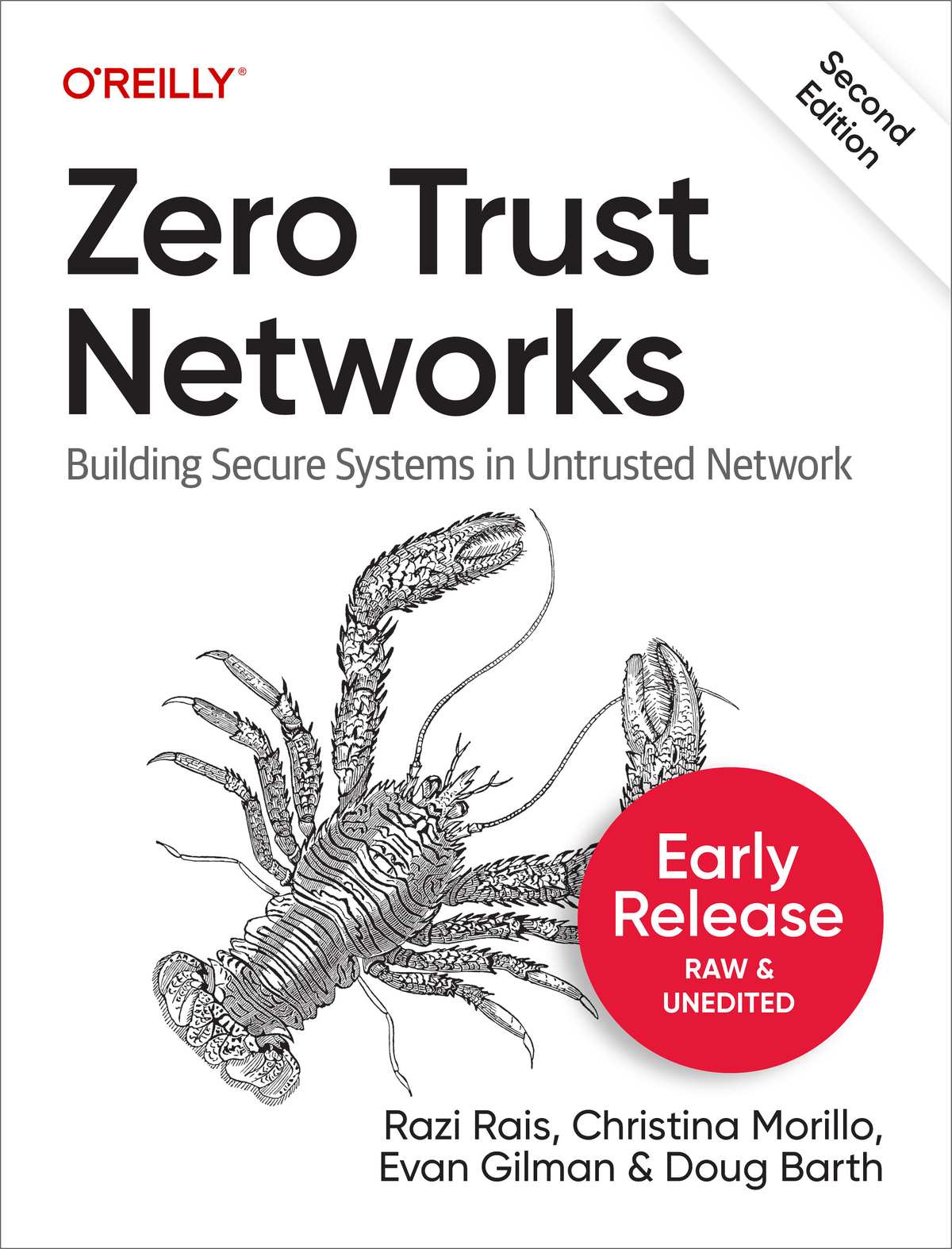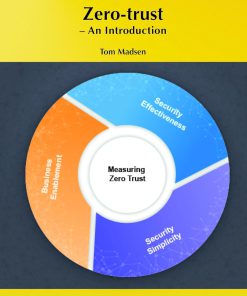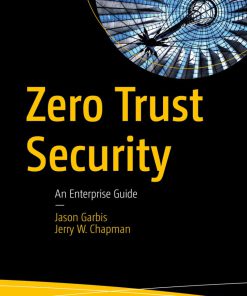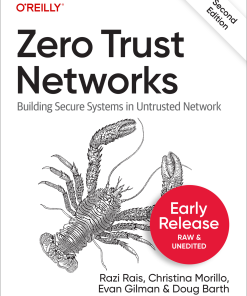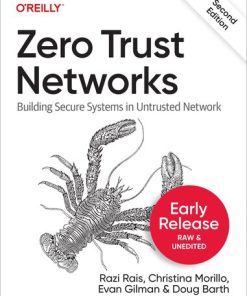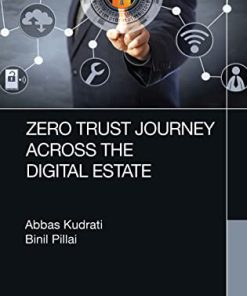Zero Trust Networks Building Secure Systems in Untrusted Networks 2nd Edition by Razi Rais, Christina Morillo, Evan Gilman, Doug Barth ISBN 1492096555 9781492096559
$50.00 Original price was: $50.00.$25.00Current price is: $25.00.
Zero Trust Networks: Building Secure Systems in Untrusted Networks 2nd Edition by Razi Rais, Christina Morillo, Evan Gilman, Doug Barth – Ebook PDF Instant Download/Delivery: 1492096555, 9781492096559
Full download Zero Trust Networks: Building Secure Systems in Untrusted Networks 2nd Edition after payment
Product details:
ISBN 10: 1492096555
ISBN 13: 9781492096559
Author: Razi Rais, Christina Morillo, Evan Gilman, Doug Barth
Zero Trust Networks: Building Secure Systems in Untrusted Networks 2nd Edition:
This practical book provides a detailed explanation of the zero trust security model. Zero trust is a security paradigm shift that eliminates the concept of traditional perimeter-based security and requires you to “always assume breach” and “never trust but always verify.” The updated edition offers more scenarios, real-world examples, and in-depth explanations of key concepts to help you fully comprehend the zero trust security architecture.
- Examine fundamental concepts of zero trust security model, including trust engine, policy engine, and context aware agents
- Understand how this model embeds security within the system’s operation, with guided scenarios at the end of each chapter
- Migrate from a perimeter-based network to a zero trust network in production
- Explore case studies that provide insights into organizations’ zero trust journeys
- Learn about the various zero trust architectures, standards, and frameworks developed by NIST, CISA, DoD, and others
Zero Trust Networks: Building Secure Systems in Untrusted Networks 2nd Edition Table of contents:
- 1. Zero Trust Fundamentals
- What Is a Zero Trust Network?
- Introducing the Zero Trust Control Plane
- Evolution of the Perimeter Model
- Managing the Global IP Address Space
- Birth of Private IP Address Space
- Private Networks Connect to Public Networks
- Birth of NAT
- The Contemporary Perimeter Model
- Evolution of the Threat Landscape
- Perimeter Shortcomings
- Where the Trust Lies
- Automation as an Enabler
- Perimeter Versus Zero Trust
- Applied in the Cloud
- Role of Zero Trust in National Cybersecurity
- Summary
- What Is a Zero Trust Network?
- 2. Managing Trust
- Threat Models
- Common Threat Models
- Zero Trust’s Threat Model
- Strong Authentication
- Authenticating Trust
- What Is a Certificate Authority?
- Importance of PKI in Zero Trust
- Private Versus Public PKI
- Public PKI Is Better than None
- Least Privilege
- Dynamic Trust
- Trust Score
- Challenges with Trust Scores
- Control Plane Versus Data Plane
- Summary
- Threat Models
- 3. Context-Aware Agents
- What Is an Agent?
- Agent Volatility
- What’s in an Agent?
- How Is an Agent Used?
- Agents Are Not for Authentication
- How to Expose an Agent?
- Rigidity and Fluidity, at the Same Time
- Standardization Desirable
- In the Meantime?
- Summary
- What Is an Agent?
- 4. Making Authorization Decisions
- Authorization Architecture
- Enforcement
- Policy Engine
- Policy Storage
- What Makes Good Policy?
- Who Defines Policy?
- Policy Reviews
- Trust Engine
- What Entities Are Scored?
- Exposing Scores Considered Risky
- Data Stores
- Scenario Walkthrough
- Summary
- 5. Trusting Devices
- Bootstrapping Trust
- Generating and Securing Identity
- Identity Security in Static and Dynamic Systems
- Authenticating Devices with the Control Plane
- X.509
- TPMs
- TPMs for Device Authentication
- HSM and TPM Attack Vectors
- Hardware-Based Zero Trust Supplicant?
- Inventory Management
- Knowing What to Expect
- Secure Introduction
- Renewing and Measuring Device Trust
- Local Measurement
- Remote Measurement
- Unified Endpoint Management (UEM)
- Software Configuration Management
- CM-Based Inventory
- Searchable Inventory
- Secure Source of Truth
- Using Device Data for User Authorization
- Trust Signals
- Time Since Image
- Historical Access
- Location
- Network Communication Patterns
- Machine Learning
- Scenario Walkthrough
- Use Case: Bob Wants to Send a Document for Printing
- Request Analysis
- Use Case: Bob Wants to Delete an Email
- Request Analysis
- Summary
- Bootstrapping Trust
- 6. Trusting Identities
- Identity Authority
- Bootstrapping Identity in a Private System
- Government-Issued Identification
- Nothing Beats Meatspace
- Expectations and Stars
- Storing Identity
- User Directories
- Directory Maintenance
- When to Authenticate Identity
- Authenticating for Trust
- Trust as the Authentication Driver
- The Use of Multiple Channels
- Caching Identity and Trust
- How to Authenticate Identity
- Something You Know: Passwords
- Something You Have: TOTP
- Something You Have: Certificates
- Something You Have: Security Tokens
- Something You Are: Biometrics
- Behavioral Patterns
- Out-of-Band Authentication
- Single Sign-On
- Workload Identities
- Moving Toward a Local Auth Solution
- Authenticating and Authorizing a Group
- Shamir’s Secret Sharing
- Red October
- See Something, Say Something
- Trust Signals
- Scenario Walkthrough
- Use Case: Bob Wants to View a Sensitive Financial Report
- Request Analysis
- Summary
- 7. Trusting Applications
- Understanding the Application Pipeline
- Trusting Source Code
- Securing the Repository
- Authentic Code and the Audit Trail
- Code Reviews
- Trusting Builds
- Software Bill of Materials (SBOM): The Risk
- Trusted Input, Trusted Output
- Reproducible Builds
- Decoupling Release and Artifact Versions
- Trusting Distribution
- Promoting an Artifact
- Distribution Security
- Integrity and Authenticity
- Trusting a Distribution Network
- Humans in the Loop
- Trusting an Instance
- Upgrade-Only Policy
- Authorized Instances
- Runtime Security
- Secure Coding Practices
- Isolation
- Active Monitoring
- Secure Software Development Lifecycle (SDLC)
- Requirements and Design
- Coding and Implementation
- Static and Dynamic Code Analysis
- Peer Reviews and Code Audits
- Quality Assurance and Testing
- Deployment and Maintenance
- Continuous Improvement
- Protecting Application and Data Privacy
- When You Host Applications in a Public Cloud, How Can You Trust It?
- Confidential Computing
- Understanding Hardware-Based Root-of-Trust (RoT)
- Role of Attestation
- Scenario Walkthrough
- Use Case: Bob Sends Highly Sensitive Data to Financial Application for Computation
- Request Analysis
- Summary
- 8. Trusting the Traffic
- Encryption Versus Authentication
- Authenticity Without Encryption?
- Bootstrapping Trust: The First Packet
- FireWall KNock OPerator (fwknop)
- Short-Lived Exceptions
- SPA Payload
- Payload Encryption
- HMAC
- Where Should Zero Trust Be in the Network Model?
- Client and Server Split
- Network Support Issues
- Device Support Issues
- Application Support Issues
- A Pragmatic Approach
- Microsoft Server Isolation
- The Protocols
- IKE and IPsec
- Mutually Authenticated TLS (mTLS)
- Trusting Cloud Traffic: Challenges and Considerations
- Cloud Access Security Brokers (CASBs) and Identity Federation
- Filtering
- Host Filtering
- Bookended Filtering
- Intermediary Filtering
- Scenario Walkthrough
- Use Case: Bob Requests Access to an Email Service Over an Anonymous Proxy Network
- Request Analysis
- Summary
- 9. Realizing a Zero Trust Network
- The First Steps Toward a Zero Trust Network: Understanding Your Current Network
- Choosing Scope
- Assessment and Planning
- Requirements: What Is Actually Required?
- All Network Flows MUST Undergo Authentication Before Processing
- Building a System Diagram
- Understanding Your Flows
- Micro-Segmentation
- Software-Defined Perimeter
- Controller-Less Architecture
- “Cheating” with Configuration Management
- Implementation Phase: Application Authentication and Authorization
- Authenticating Load Balancers and Proxies
- Relationship-Oriented Policy
- Policy Distribution
- Defining and Implementing Security Policies
- Zero Trust Proxies
- Client-Side Versus Server-Side Migrations
- Endpoint Security
- Case Studies
- Case Study: Google BeyondCorp
- The Major Components of BeyondCorp
- Leveraging and Extending the GFE
- Challenges with Multiplatform Authentication
- Migrating to BeyondCorp
- Lessons Learned
- Conclusion
- Case Study: PagerDuty’s Cloud-Agnostic Network
- Configuration Management as an Automation Platform
- Dynamically Calculated Local Firewalls
- Distributed Traffic Encryption
- Decentralized User Management
- Rollout
- Value of a Provider-Agnostic System
- Summary
- The First Steps Toward a Zero Trust Network: Understanding Your Current Network
- 10. The Adversarial View
- Potential Pitfalls and Dangers
- Attack Vectors
- Identity and Access
- Credential Theft
- Privilege Escalation and Lateral Movement
- Infrastructure and Networks
- Control Plane Security
- Endpoint Enumeration
- Untrusted Computing Platform
- Distributed Denial of Service (DDoS) Attacks
- Man-in-the-Middle (MitM) Attacks
- Invalidation
- Phishing
- Physical Coercion
- Role of Cyber Insurance
- Summary
- 11. Zero Trust Architecture Standards, Frameworks, and Guidelines
- Governments
- United States
- United Kingdom
- European Union
- Private and Public Organizations
- Cloud Security Alliance (CSA)
- The Open Group
- Gartner
- Forrester
- International Organization for Standardization (ISO)
- Commercial Vendors
- Summary
- Governments
- 12. Challenges and the Road Ahead
- Challenges
- Mindset Shift
- Shadow IT
- Siloed Organizations
- Lack of Cohesive Zero Trust Products
- Scalability and Performance
- Key Takeaways
- Technological Advancements
- Quantum Computing
- Artificial Intelligence
- Privacy-Enhancing Technologies
- Summary
- Challenges
People also search for Zero Trust Networks: Building Secure Systems in Untrusted Networks 2nd Edition:
building zero trust networks
zero trust networks book
cloudflare zero trust networks
zero trust networks pdf
zero trust networks 2nd edition pdf
zero trust networks book pdf
Tags:
Razi Rais,Christina Morillo,Evan Gilman,Doug Barth,Zero Trust,Networks Building,Secure Systems,Untrusted Networks
You may also like…
Uncategorized
Computers - Security
Zero Trust Security An Enterprise Guide 1st Edition Jason Garbis
Computers - Security
Zero Trust Access For Dummies, Fortinet Special Edition Lawrence Miller
Computers - Computer Science
Computers - Security
Zero Trust Networks, 2nd Edition (First Early Release) Razi Rais
Uncategorized
Computers - Security
Zero Trust Journey Across the Digital Estate 1st Edition Abbas Kudrati

